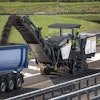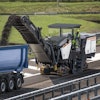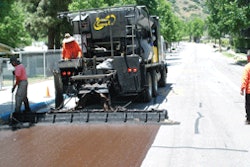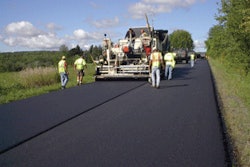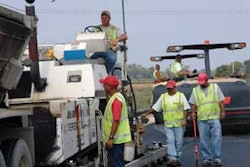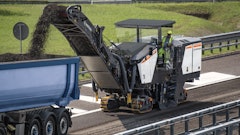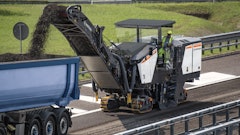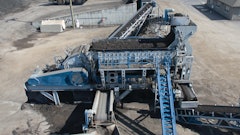A two-mile stretch of Overland Park's Antioch Road, from 151st Street to 167th Street, was in dire need of improvement due to increased traffic demand spurred by residential growth and a new Blue Valley School District complex.
The progressive Kansas community made this $13.6 million project a top priority during the 2009 construction season, requiring a coordinated effort among all involved to deliver on the key objectives of improving traffic flow and safety in an increasingly busy corridor that serves a rapidly growing section of southern Overland Park.
Of primary concern was to provide safer access to a multi-school complex, which generates a traffic volume of 3,000 vehicles per day. Projected traffic through this corridor is expected to nearly triple from 9,000 to 26,000 vehicles a day over the next 20 years.
The project involved widening an existing two-lane roadway to a four-lane, median-divided thoroughfare. A wide median was constructed to accommodate a six-lane roadway in the future with minimal encroachment on adjacent properties.
The new road construction consisted of a 10-inch full-depth fractionated recycled asphalt pavement (FRAP) over a six-inch open-graded aggregate drainage base. The top eight inches of subgrade were fly ash modified to further enhance pavement life. A new traffic signal was installed at the 159th and Antioch intersection (just north of the school complex) to further improve capacity and safety.
The project team managed traffic control and construction phasing to minimize disruption to the traveling public during construction. Antioch Road serves as the only access to the three-school campus, so student access and safety was a major element of the phasing effort.
Adopting new mix designs
The project included considerable use of temporary pavements designed to carry relatively high traffic volumes during the various construction phases. The city and primary contractor, O'Donnell and Sons Construction, partnered on the design of the asphalt used for the temporary pavement to test various asphalt mix designs containing varying contents of recycled materials.
This testing was used for an engineering study that was independently reviewed by two respected materials engineering firms. The research led the city to adopt a new Superpave asphalt specification that allows the use of both fractionated recycled asphalt pavement (FRAP) and recycled asphalt pavement (RAP). A notable feature of the specification is that it allows high percentages of FRAP in the mix. The study demonstrated that with careful control and design, FRAP, and to a lesser degree RAP, pavements can actually outperform mixes with all virgin materials.
Because the research was completed and reviewed prior to the conclusion of permanent paving on the project, Antioch Road became the first high-volume thoroughfare in Overland Park to use the new specification with a Superpave surface mix that utilized 35% FRAP.
As a bonus, that negotiated change saved the city $62,000 on this project alone, more than paying for the research that led to the new environmentally-friendly specification.
The project earned both a national and local project of the year award from the National Asphalt Pavement Association, recognizing the quality work performed by O'Donnell and Sons on a project over 50,000 tons.
O'Donnell's 'going green' initiative
After the project was bid with all virgin material specified, O'Donnell and Sons requested the city consider incorporating recycled asphalt mixes into the project. This was new territory for the city, having never specified recycled mixes.
The city and contractor took advantage of the temporary pavements required during construction to test various recycled mix designs. Satisfied with how those test designs performed, the city approved the change to incorporate recycled content into the permanent mix designs used in constructing the new roadway.
Recycled mixes were used for both base course and surface course mix designs, allowing the city to meet its ongoing "green" sustainability objectives, as well as achieve savings in the final construction costs.
"It was a challenging project due to the complicated phasing we had to follow in order to keep the road open while relocating all the utilities," notes Patrick O'Donnell, estimator in charge of the project.
"What made the project successful for us and the city was the fact that we worked together in developing new mix design specifications that incorporated a lot of recycled materials into the final project that saved the city money and provided a new specification for all future projects," he continues. "The final design allows for up to 35% FRAP. On this project we used that amount on the two four-inch base courses and the two-inch surface course. As the contractor, we saw an opportunity to save the city money by using material recycled from the existing two-lane road, as well as our own RAP stockpiles. We brought in a FRAP processing system to control the final recycled materials we added to the new mix produced."
As O'Donnell points out, Overland Park is a leader among Kansas municipalities when it comes to implementing innovative solutions for building and maintaining its road network, and many other road agencies across the states adopt many of the approaches Overland initiates.
Agency perspective
Brian Scovill, an engineer and project manager for Overland Park, and Mike Ross, another city engineer and materials manager, say the new recycled mix design is an ongoing effort to improve the city's overall asphalt specifications in an effort to achieve a cost-effective quality pavement that performs well for the traveling public.
"We worked with an outside consultant who's been very involved with the National Center of Asphalt Testing in analyzing the use of high-recycled content in our Superpave design," Scovill notes. "State DOT (Department of Transportation) specifications limit the use of RAP to 20-25% without compensating binder modifications. We wanted to know if we could use RAP with our standard PG 64-22 binder specification and how much could we use. This project allowed us to increase FRAP content during the placement of temporary pavements, and the cores and tests we conducted on those pavements enabled us to come up with real-world analysis. In fact, the tests showed that we could increase FRAP content by as much as 40%."
Due to some of the soft, more absorbent qualities of the aggregate available in Eastern Kansas, final mix specifications limited FRAP usage to 35%.
"Local asphalt suppliers have not gone over the 30-35% recycled content because the quality of our rock in this part of the state is softer, and we would have to modify our standard PG 64-22 binder to accommodate the absorption of that rock," Scovill says.
"We determined that 35% is the maximum RAP content we could allow without changing the binder, and the binder is based on the ESAL (equivalent single axle load) the mix is designed to carry," he continues. "Our Superpave mix (3/8-1/2 inch aggregate) is designed to provide high-speed skid resistance with the soft rock that's available, and we don't want to start making a lot of changes in the binder content that may alter that performance characteristic."
During the testing process, as Ross points out, O'Donnell and Sons placed pavements with 10%, 15%, 20% and 25% RAP content to eventually come up with a final mix design containing 35% FRAP.
"They (O'Donnell) were very careful in separating and managing incoming streams of RAP," Ross says. "We required extraction samples of all the mixes using the various RAP content they were adding to the mixes for the project. They provided all the QC (quality control) and we hired an independent QA (quality assurance) firm to verify the results. We've (City of Overland Park) since adopted the FRAP Superpave design for all projects."
For the City of Overland Park, the Antioch Road project not only improved traffic flow and safety for those who rely on this critical corridor, it also proved essential in the development of new specifications that allow the city to continue to deliver cost-effective, quality pavements that will serve the community and taxpayers well for years to come.



